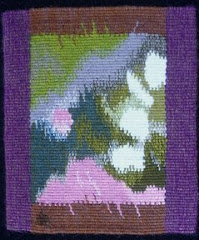Tapestry Weaving Workshop with Janet Austin

Work in progress: Janet’s 2015 calendar tapestry
Saturday 24 October and Sunday 25 October 2015
9.30-12.30 and 1.30-4.30
Class description: Tapestries can be woven on any loom, but frame looms have the advantage of being inexpensive and portable. In this 2-day class, participants will learn basic tapestry techniques for creating shapes, a mini tapestry design lesson and information about tapestry tools and materials. No previous experience is required.
Cost: $175 for the 2-day workshop. Checks should be made payable to the Nashoba Valley Weavers’ Guild.
Materials fee: $35 per student materials fee is payable to Janet on the first day of class. The fee includes yarn and a frame loom. You get to keep the loom but if you prefer you can return it for a $25 refund.
Supplies: Notebook, pencil and scissors. Bringing your own yarn is optional.
There are a maximum of 8 students in this class. We will take checks to reserve your spot on a first come, first served basis beginning at the Guild pot luck on Tuesday 23 June. If you want to sign up for the class but are not coming to the pot luck, please contact Penny before 6 pm on Tuesday 23 June. If there are more than 8, we will have a random drawing of all those signed up on the first day.
There is a possibility that we will schedule a second session of the same class if there is enough demand. So if you are interested in the class but cannot go the weekend we have scheduled, please let us know.
Janet Austen, Tapestry Weaver

Floral Fragments #6 by Janet Austen
BFA, Fibers, Massachusetts College of Art
MFA, Painting, University of North Carolina at Greensboro
Coordinator and Secretary, 1993-2009, Tapestry Weavers in New
Board of Directors, 2001-2009, American Tapestry Alliance
Member: Weavers Guild of RI, Art League of RI.
Janet Austin has been weaving since 1972. She has taught weaving and spinning classes at the Durham (NC) Arts Council, Slater Mill, Court House Center for the Arts, various elementary schools, at the New England Weavers Seminar (NEWS), and in her studio. Her tapestries are exhibited nationally, most recently in Small Expressions 2014, The Art is the Cloth, and the upcoming Small Tapestry International 4. Janet lectures about tapestry, writes articles for Tapestry Topics, the newsletter of the American Tapestry Alliance, and is author of the blog: Tangled Web www.austintapestry.blogspot.com




